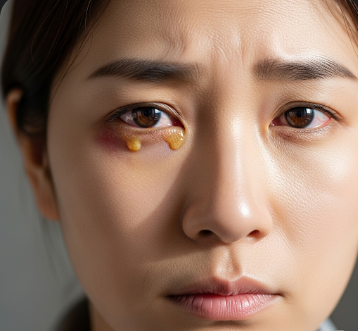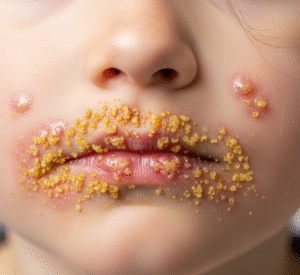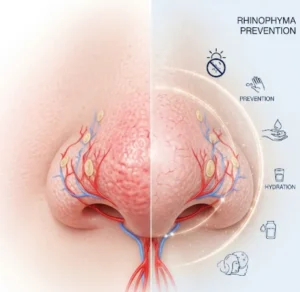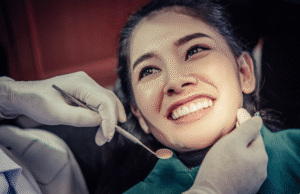Overview
Eye discharge, often referred to as “eye mucus” or “eye gunk,” is a common symptom where fluid accumulates in or around the eyes. It can range from watery, sticky, yellow, green, or bloody discharge depending on the underlying cause. Eye discharge is not always serious, but persistent or severe discharge may indicate infection, allergy, or other eye conditions. In Korea, hospitals and ophthalmology clinics provide comprehensive diagnosis, treatment, and preventive care for eye discharge.
Key Facts
▶ Prevalence: Affects people of all ages; particularly common in infants, children, and individuals with allergies.
▶ Causes: Conjunctivitis (bacterial or viral), blocked tear ducts, allergies, dry eyes, or foreign bodies.
▶ Associated Symptoms: Redness, itching, swelling, blurred vision, and crusting around the eyes.
▶ Treatment Options in Korea: Eye drops, antibiotics, antihistamines, warm compresses, and minor surgical interventions for chronic cases.
▶ Urgency: Severe, persistent, or painful discharge requires medical evaluation to prevent complications.
What is Eye Discharge?
Eye discharge refers to any fluid, mucus, or pus that drains from the eyes, often accumulating during sleep or in response to irritation. Its color, consistency, and volume provide clues about the underlying cause.
▶ Watery Discharge: Often linked to viral infections or allergies.
▶ Sticky or Pus-like Discharge: Commonly indicates bacterial infection.
▶ Bloody Discharge: May result from trauma, severe infection, or vascular issues.
▶ Chronic or Recurrent Discharge: Could be caused by blocked tear ducts or chronic conjunctivitis.
▶ Unilateral vs. Bilateral: One eye affected often points to localized infection, while both eyes suggest allergies or systemic issues.
Note: Understanding the type of discharge is essential for accurate diagnosis and effective treatment.
What Symptoms Are Related to Eye Discharge?
▶ Redness: Conjunctival inflammation often accompanies discharge.
▶ Itching or Irritation: Common in allergic reactions.
▶ Swelling of Eyelids: May indicate infection or inflammation.
▶ Blurred Vision: Accumulated discharge can temporarily obscure vision.
▶ Crusting: Particularly after sleep, sticky or yellow crusts may form.
▶ Tearing: Excessive tearing can accompany watery discharge.
▶ Pain or Burning Sensation: Indicates irritation, infection, or foreign body presence.
▶ Sensitivity to Light (Photophobia): May occur with viral or severe bacterial infections.
What Causes / Possible Causes
Eye discharge can result from various infectious, allergic, or structural factors:
▶ Conjunctivitis:
▶ Bacterial: Produces yellow/green sticky discharge; often one eye initially.
▶ Viral: Causes watery discharge, redness, and irritation; usually affects both eyes.
▶ Allergic: Clear, watery discharge with itching and swelling; seasonal or environmental triggers.
▶ Blocked Tear Ducts: Common in infants, causing chronic watery eyes and crusting.
▶ Blepharitis: Inflammation of the eyelid margins leading to crusty discharge.
▶ Dry Eye Syndrome: Can cause reflex tearing and stringy discharge.
▶ Foreign Bodies or Trauma: Particles or injury can trigger watery or bloody discharge.
▶ Contact Lens Complications: Improper hygiene or overuse can lead to discharge and infection.
▶ Systemic Infections: Sinusitis or other upper respiratory infections can cause secondary eye discharge.
Note: Identifying the exact cause is crucial to prevent vision-threatening complications.
When Should I See a Doctor?
▶ Persistent Discharge: Lasting more than a few days despite home care.
▶ Severe Pain or Redness: May indicate serious infection or corneal involvement.
▶ Visual Disturbances: Blurred vision, light sensitivity, or sudden vision changes.
▶ Bilateral or Recurrent Symptoms: Suggest systemic or allergic causes.
▶ Associated Fever or Malaise: May indicate systemic infection.
▶ Trauma or Foreign Object: Immediate evaluation is required.
▶ Children or Infants: Newborn eye discharge should be promptly assessed for blocked tear ducts or infection.
Tip: Korean ophthalmology clinics provide rapid evaluation, laboratory testing, and tailored treatment plans for eye discharge.
Care and Treatment
Management depends on cause, severity, and age:
▶ Hygiene Measures: Gently clean eyes with sterile water or saline; avoid rubbing.
▶ Warm Compresses: Soothes irritation and helps unblock tear ducts in infants.
▶ Medicated Eye Drops or Ointments: Antibiotics for bacterial infection, antihistamines for allergies.
▶ Artificial Tears: Relief for dry eyes and mild irritation.
▶ Removal of Foreign Objects: Done under medical supervision.
▶ Contact Lens Care: Proper hygiene and temporary discontinuation if needed.
▶ Surgical Intervention: Minor procedures for blocked tear ducts or chronic blepharitis.
▶ Monitoring: Regular follow-up to ensure infection resolution and prevent recurrence.
Treatment Options in Korea
Medical Evaluation:
▶ Ophthalmic Examination: Slit-lamp inspection, visual acuity testing, and ocular surface assessment.
▶ Laboratory Tests: Cultures of eye discharge if bacterial infection is suspected.
▶ Imaging: Rarely required for chronic or complex cases.
▶ Specialist Consultation: Ophthalmologists or pediatric eye specialists for targeted therapy.
Advanced Therapies:
▶ Prescription Antibiotics or Antivirals: Depending on causative agent.
▶ Allergy Management: Antihistamines, mast cell stabilizers, or immunotherapy for allergic eye discharge.
▶ Dacryocystorhinostomy (DCR): Surgical correction of blocked tear ducts in infants or adults.
▶ Multidisciplinary Care: Coordination between ENT, ophthalmology, and pediatric teams when systemic issues are involved.
Rehabilitation & Support:
▶ Patient Education: Proper eye hygiene, avoidance of irritants, and timely treatment adherence.
▶ Follow-Up Care: Ensures complete resolution and prevents chronic complications.
▶ Specialist Clinics: Korean hospitals provide integrated care combining diagnostics, medical therapy, and minor surgical interventions.
Outcome: With early recognition and comprehensive treatment in Korea, eye discharge can be effectively managed, relieving discomfort, preventing infection spread, and preserving vision health.













